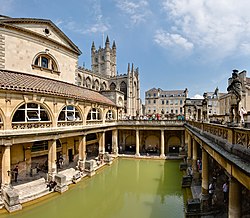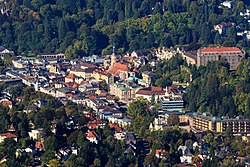| UNESCO World Heritage Site | |
|---|---|
 The Roman Baths in Bath, England, one of the spa towns within the World Heritage Site | |
| Location | Austria, Belgium, Czech Republic, France, Germany, Italy, United Kingdom |
| Includes | Eleven spa towns in Europe |
| Criteria | Cultural: (ii)(iii) |
| Reference | 1613 |
| Inscription | 2021 (44th Session) |
| Area | 7,014 ha (17,330 acres) |
| Buffer zone | 11,319 ha (27,970 acres) |
The Great Spa Towns of Europe is a transnational World Heritage Site consisting of a selection of 11 spa towns across seven European countries. They were developed around natural mineral water springs. [1] [2] From the early 18th century to the 1930s, Western Europe experienced an increase in spa and bathing culture, leading to the construction of elaborate bath houses. [1] These would often include gardens, casinos, theatres, and villas surrounding the springs and the bath houses. [1] [3]












